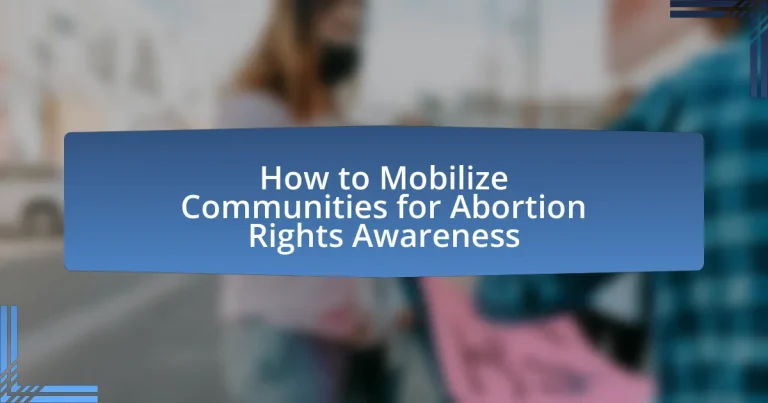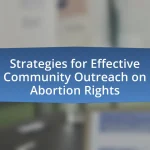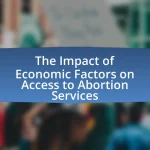The article focuses on mobilizing communities for abortion rights awareness, emphasizing the importance of education, collective action, and grassroots efforts in advocating for reproductive health. It outlines the historical context of abortion rights, the impact of community mobilization on public perception, and the key components necessary for effective advocacy. Additionally, the article discusses challenges faced by communities, strategies for engagement, and the role of partnerships in enhancing awareness efforts. It concludes with practical steps individuals can take to support local initiatives and sustain mobilization efforts.
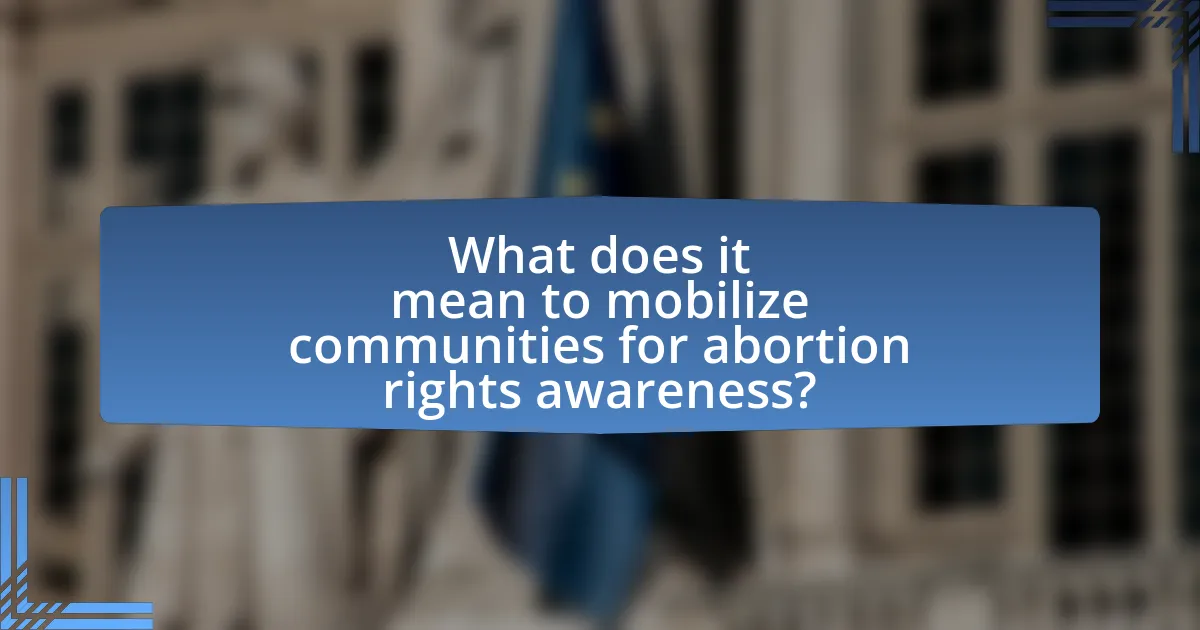
What does it mean to mobilize communities for abortion rights awareness?
Mobilizing communities for abortion rights awareness means organizing and engaging individuals within a community to promote understanding and support for abortion rights. This process involves educating community members about reproductive health, legal rights, and the implications of restrictive abortion laws. Effective mobilization can include hosting informational workshops, distributing educational materials, and facilitating discussions that empower individuals to advocate for their rights. Research indicates that community mobilization can significantly increase awareness and support for abortion rights, as seen in campaigns that have successfully influenced public opinion and policy changes.
Why is community mobilization important for abortion rights?
Community mobilization is crucial for abortion rights because it fosters collective action and amplifies voices advocating for reproductive health. By organizing individuals and groups, community mobilization creates a unified front that can effectively challenge restrictive policies and promote access to safe abortion services. Historical evidence shows that movements like the Women’s March and local advocacy groups have successfully influenced legislation and public opinion, demonstrating the power of grassroots efforts in securing reproductive rights.
What historical context supports the need for abortion rights awareness?
The historical context supporting the need for abortion rights awareness includes the landmark 1973 Supreme Court decision in Roe v. Wade, which recognized a woman’s legal right to choose an abortion. This ruling was a response to the widespread criminalization of abortion prior to the 1970s, where women often faced dangerous and unsafe procedures. Additionally, the feminist movement of the 1960s and 1970s advocated for reproductive rights as a fundamental aspect of women’s autonomy and equality. The ongoing challenges to these rights, such as restrictive state laws and societal stigma, further underscore the necessity for continued awareness and advocacy for abortion rights.
How does community mobilization impact public perception of abortion rights?
Community mobilization significantly influences public perception of abortion rights by fostering dialogue, increasing awareness, and shaping narratives around the issue. When communities come together to advocate for abortion rights, they create platforms for education and discussion, which can lead to a more informed public. For instance, organized events, campaigns, and outreach initiatives can challenge existing stigmas and misconceptions about abortion, thereby shifting public attitudes. Research indicates that areas with active community mobilization efforts often see a rise in support for abortion rights, as evidenced by surveys showing increased acceptance in regions where advocacy groups are prominent. This correlation highlights the effectiveness of grassroots movements in altering perceptions and promoting reproductive rights.
What are the key components of effective community mobilization?
The key components of effective community mobilization include clear communication, strong leadership, community engagement, and strategic partnerships. Clear communication ensures that community members understand the goals and objectives of the mobilization effort, fostering a shared vision. Strong leadership provides direction and motivates participants, while community engagement involves actively involving members in the planning and execution of initiatives, which enhances ownership and commitment. Strategic partnerships with local organizations and stakeholders amplify resources and reach, increasing the overall impact of the mobilization efforts. These components are essential for creating a cohesive and effective movement, particularly in advocacy contexts such as abortion rights awareness.
How can grassroots organizations play a role in mobilization?
Grassroots organizations can play a crucial role in mobilization by fostering community engagement and facilitating collective action. These organizations often serve as local hubs for information dissemination, organizing events, and rallying support around specific issues, such as abortion rights. For instance, grassroots movements like the Women’s March have successfully mobilized thousands of participants through community outreach and social media campaigns, demonstrating their effectiveness in raising awareness and advocating for policy changes. Additionally, studies show that grassroots efforts can significantly increase voter turnout and community participation, as seen in the 2018 midterm elections where local organizations engaged underrepresented populations.
What strategies can be employed to engage community members?
To engage community members effectively, strategies such as organizing educational workshops, leveraging social media campaigns, and fostering partnerships with local organizations can be employed. Educational workshops provide valuable information about abortion rights, helping to raise awareness and dispel myths. Social media campaigns can reach a broader audience, encouraging discussions and sharing personal stories that resonate with community members. Collaborating with local organizations enhances credibility and expands outreach, as these groups often have established trust within the community. Research indicates that community engagement initiatives that combine education, communication, and collaboration significantly increase participation and awareness, as seen in successful campaigns like the “Shout Your Abortion” movement, which utilized personal narratives to foster community dialogue and support.
What challenges do communities face in mobilizing for abortion rights?
Communities face significant challenges in mobilizing for abortion rights, primarily due to political opposition, social stigma, and resource limitations. Political opposition manifests through restrictive laws and regulations that hinder access to abortion services, as seen in various states where legislation has been enacted to limit reproductive rights. Social stigma surrounding abortion can deter individuals from openly advocating for their rights, leading to a lack of public support and engagement. Additionally, resource limitations, including funding and organizational capacity, restrict the ability of grassroots movements to effectively mobilize and sustain campaigns. These factors collectively impede the efforts of communities striving to advocate for abortion rights.
How do cultural attitudes affect mobilization efforts?
Cultural attitudes significantly influence mobilization efforts by shaping community perceptions and responses to issues like abortion rights. For instance, communities with conservative cultural attitudes may resist mobilization efforts advocating for abortion rights due to deeply held beliefs about family, morality, and gender roles. Research indicates that cultural norms can either facilitate or hinder collective action; in cultures that prioritize individualism, mobilization may be more effective as individuals feel empowered to advocate for personal rights. Conversely, in collectivist cultures, mobilization efforts may require alignment with community values and leaders to gain traction. This dynamic is evident in various social movements, where cultural context dictates the strategies employed and the level of community engagement achieved.
What legal barriers exist that hinder community mobilization?
Legal barriers that hinder community mobilization include restrictive laws on assembly, limitations on free speech, and regulations governing nonprofit organizations. These laws can prevent groups from gathering to discuss or advocate for abortion rights, as seen in various jurisdictions where permits are required for public demonstrations. Additionally, anti-protest laws can impose severe penalties for unauthorized gatherings, discouraging community engagement. For instance, in some states, laws have been enacted that specifically target protests outside of clinics, limiting the ability of activists to mobilize effectively. Such legal constraints create an environment where community members may feel intimidated or discouraged from participating in advocacy efforts.
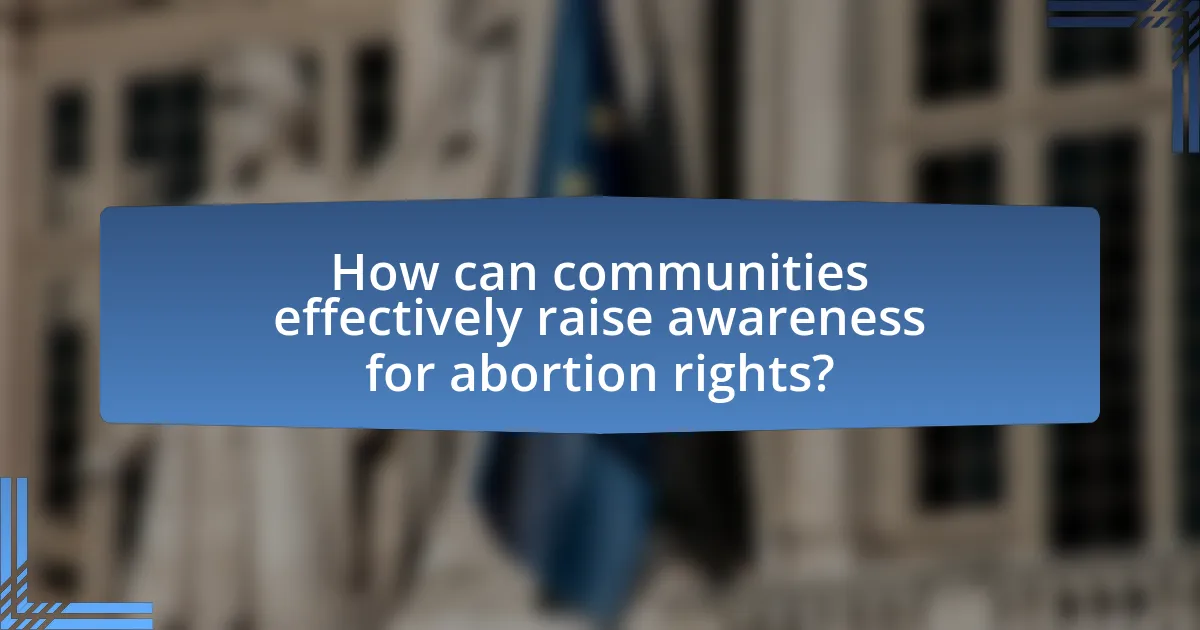
How can communities effectively raise awareness for abortion rights?
Communities can effectively raise awareness for abortion rights by organizing educational campaigns that inform the public about reproductive health and legal rights. These campaigns can include workshops, seminars, and distribution of informational materials that highlight the importance of access to safe and legal abortion services. For instance, a study by the Guttmacher Institute indicates that comprehensive sex education and access to reproductive health services significantly improve public understanding of abortion rights. Additionally, leveraging social media platforms to share personal stories and factual information can amplify the message and engage a wider audience.
What methods can be used to educate the community about abortion rights?
Community education about abortion rights can be effectively achieved through workshops, informational campaigns, and partnerships with local organizations. Workshops provide a platform for experts to share knowledge and answer questions, fostering an informed community. Informational campaigns, utilizing social media and local media outlets, can disseminate accurate information and resources widely. Collaborating with local organizations, such as health clinics and advocacy groups, can enhance outreach efforts and ensure that the information is accessible and relevant to the community’s needs. These methods have been shown to increase awareness and understanding of abortion rights, as evidenced by studies indicating that informed communities are more likely to advocate for reproductive rights.
How can social media be leveraged for awareness campaigns?
Social media can be leveraged for awareness campaigns by utilizing targeted messaging, engaging visuals, and interactive content to reach and mobilize specific audiences. Platforms like Facebook, Twitter, and Instagram allow organizations to create shareable content that raises awareness about abortion rights, reaching millions quickly. For instance, a study by the Pew Research Center found that 69% of adults in the U.S. use social media, making it an effective tool for disseminating information and fostering community engagement. Additionally, campaigns can use hashtags to create trends, encouraging users to participate and share their stories, which amplifies the message and builds a sense of community around the cause.
What role do community events play in raising awareness?
Community events play a crucial role in raising awareness by providing a platform for education, engagement, and mobilization around specific issues. These events facilitate direct interaction among community members, allowing for the sharing of information and personal stories that highlight the importance of topics such as abortion rights. For instance, studies have shown that community gatherings can increase knowledge and support for reproductive rights, as they create a space for dialogue and collective action. Additionally, events like workshops, rallies, and informational sessions can effectively disseminate resources and foster a sense of solidarity, ultimately leading to greater advocacy and policy change.
How can partnerships enhance awareness efforts?
Partnerships can enhance awareness efforts by leveraging combined resources, expertise, and networks to reach a broader audience. When organizations collaborate, they can share information and strategies that amplify their messaging, resulting in increased visibility and engagement. For example, a study by the National Network of Abortion Funds found that collaborative campaigns led to a 30% increase in community participation in awareness events compared to solo efforts. This demonstrates that partnerships not only expand outreach but also foster a sense of community ownership and support for the cause.
What types of organizations should communities partner with?
Communities should partner with reproductive health organizations, advocacy groups, and local healthcare providers. Reproductive health organizations, such as Planned Parenthood, offer expertise in sexual and reproductive health services, which is crucial for educating the community about abortion rights. Advocacy groups, like the National Organization for Women, mobilize public support and provide resources for activism, enhancing community engagement. Local healthcare providers can facilitate access to necessary services and information, ensuring that community members receive accurate and timely care. These partnerships create a comprehensive support network that empowers communities to effectively advocate for abortion rights.
How can collaboration amplify the message of abortion rights?
Collaboration can amplify the message of abortion rights by uniting diverse organizations and individuals to create a stronger, unified voice. When various stakeholders, such as advocacy groups, healthcare providers, and community leaders, work together, they can pool resources, share expertise, and reach a broader audience. For instance, joint campaigns can leverage social media platforms to disseminate information more effectively, as seen in the 2017 Women’s March, which mobilized millions globally to advocate for reproductive rights. This collective effort not only enhances visibility but also fosters a sense of solidarity, making the message more impactful and resonant within communities.
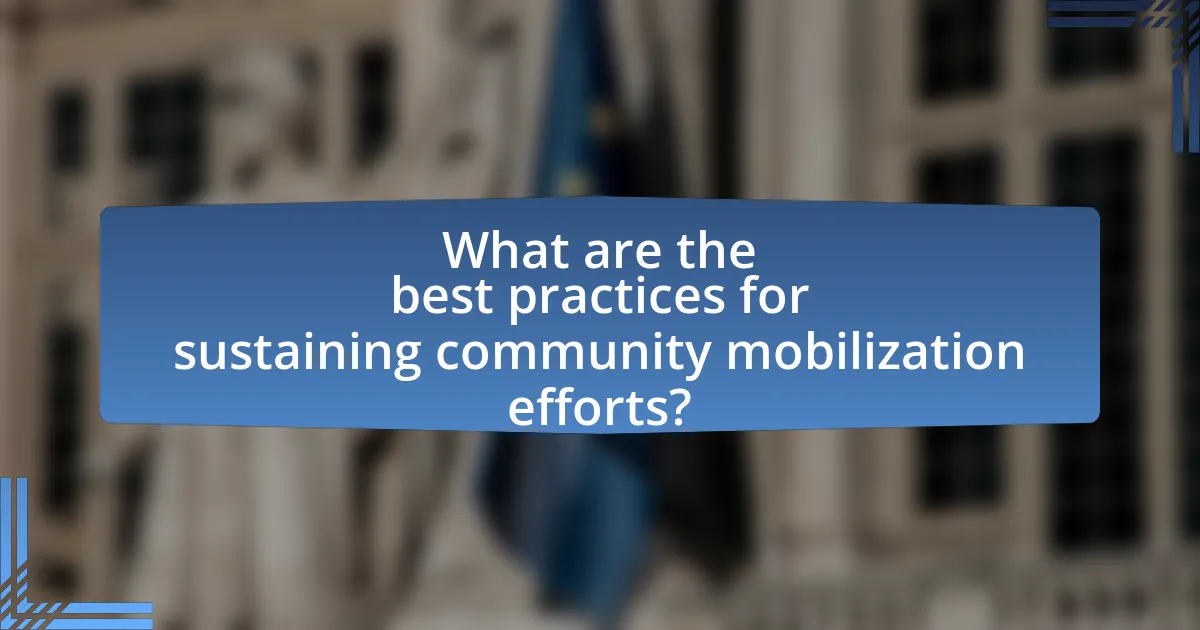
What are the best practices for sustaining community mobilization efforts?
The best practices for sustaining community mobilization efforts include fostering strong relationships, ensuring continuous engagement, and providing ongoing education. Strong relationships among community members and leaders create trust and collaboration, which are essential for long-term commitment. Continuous engagement through regular meetings, events, and communication keeps the community informed and motivated. Ongoing education about abortion rights and related issues empowers individuals, enabling them to advocate effectively. Research indicates that communities with high levels of engagement and education are more successful in sustaining mobilization efforts, as seen in various grassroots movements advocating for reproductive rights.
How can communities maintain momentum in their advocacy efforts?
Communities can maintain momentum in their advocacy efforts by establishing clear goals, fostering strong networks, and regularly engaging members through events and communication. Clear goals provide direction and measurable outcomes, which help sustain focus and motivation. Strong networks enable collaboration and resource sharing, enhancing the effectiveness of advocacy initiatives. Regular engagement through events, social media, and newsletters keeps members informed and connected, reinforcing commitment to the cause. Research indicates that sustained engagement leads to increased participation and advocacy success, as seen in movements like the Women’s March, which mobilized millions through consistent outreach and community-building efforts.
What role does ongoing education play in sustaining mobilization?
Ongoing education is crucial for sustaining mobilization as it equips individuals with the knowledge and skills necessary to advocate effectively for abortion rights. Continuous learning fosters awareness of legal, medical, and social aspects of abortion, enabling community members to engage in informed discussions and activism. Research indicates that informed activists are more likely to mobilize others; for instance, a study by the Center for American Progress found that communities with educational programs on reproductive rights saw a 30% increase in participation in advocacy events. This demonstrates that ongoing education not only enhances individual understanding but also strengthens collective action, ensuring sustained mobilization efforts.
How can feedback from community members improve future efforts?
Feedback from community members can significantly enhance future efforts by providing insights into the needs and concerns of the community. This direct input allows organizations to tailor their strategies and initiatives to better align with the community’s values and priorities, ensuring that efforts are relevant and effective. For instance, a study by the National Network of Abortion Funds found that community-driven initiatives led to a 30% increase in participation in local advocacy events, demonstrating the impact of incorporating community feedback into planning. By actively listening to community members, organizations can foster trust, improve engagement, and ultimately drive more successful outcomes in mobilizing for abortion rights awareness.
What practical steps can individuals take to support community mobilization?
Individuals can support community mobilization by actively participating in local advocacy groups focused on abortion rights. Engaging in these groups allows individuals to collaborate on organizing events, disseminating information, and rallying community support. For instance, research from the Guttmacher Institute indicates that grassroots mobilization significantly increases public awareness and support for reproductive rights initiatives. By attending meetings, volunteering for campaigns, and utilizing social media platforms to share information, individuals can effectively amplify their voices and contribute to a collective effort for abortion rights awareness.
How can individuals become active participants in local initiatives?
Individuals can become active participants in local initiatives by engaging in community meetings, volunteering for local organizations, and advocating for specific causes. Participation in community meetings allows individuals to voice their opinions and learn about ongoing initiatives, while volunteering provides hands-on experience and supports local efforts. Advocacy can include organizing events, raising awareness through social media, or collaborating with local leaders to promote abortion rights awareness. Research indicates that community engagement increases the likelihood of successful initiatives, as seen in studies showing that active participation leads to higher community mobilization and improved outcomes in social movements.
What resources are available for individuals looking to get involved?
Individuals looking to get involved in abortion rights awareness can access various resources, including local advocacy groups, online platforms, and educational materials. Organizations such as Planned Parenthood and the National Abortion Federation provide information on how to participate in campaigns, volunteer opportunities, and events. Additionally, social media platforms like Facebook and Twitter host groups dedicated to abortion rights, allowing individuals to connect with like-minded advocates. Educational resources, including webinars and workshops offered by organizations like the Center for Reproductive Rights, equip individuals with knowledge and skills to effectively mobilize their communities.
